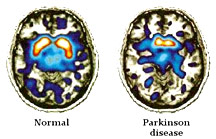


Parkinsonís (PD) Overview
 Parkinsonís Disease (PD) also known as Paralytic Agitans is a chronic and progressive degeneration of the central nervous systems. It is believed to be one of the most common movement disorders.
Parkinsonís Disease (PD) also known as Paralytic Agitans is a chronic and progressive degeneration of the central nervous systems. It is believed to be one of the most common movement disorders.In the normal brain some nerve cells produce a chemical called dopamine ithelps in transmitting signals within the brain to produce smooth movement of muscles. In Parkinson's patients, 80 percent or more of these dopamine-producing cells are damaged, dead, or otherwise degenerated. This causes the nerve cells to fire wildly, leaving patients unable to control their movements.
In the latter part of the disease Parkinson's can be crippling or disabling, But usually in the early stages of the disease Parkinsonís may be so subtle and gradual that patients sometimes ignore the symptoms or attribute them to the effects of aging.
- At first, patients may feel overly tired, "down in the dumps," or a little shaky. Their speech may become soft and they may become irritable for no reason. Movements may be stiff, unsteady, or unusually slow.
- Tremor, or trembling in hands, arms, legs, jaw, and face
- Rigidity, or stiffness of limbs and trunk
- Bradykinesia, or slowness of movement
- Postural instability or impaired balance and coordination.
- Shuffling,
- Speaking difficulties, (or speaking very softly),
- Facial masking (expressionless, mask-like face),
- Swallowing problems, and stooped posture.
- Parkinsonísdisease in certain cases in associated with depression, anxiety, personality and behavior changes, sleeps disturbances, and sexual problems.
What are the causes of Parkinsonís disease?
Top
The main cause of Parkinsonís disease is attributed to degeneration of dopamine producing cells in brain.
We do know that decrease in levels of dopamine causes Parkinsonís disease but why these cells degenerate is still not known exactly. Experts believe that dopamine loss is a combination of genetic and environmental causes.
- What is dopamine?
A chemical substance called dopamine acts as a messenger between two brain areas - the substantianigra and the corpus striatum - to produce smooth, controlled movements. In Parkinson's disease the cells producing dopamine undergo degeneration leading to lack of dopamine When the amount of dopamine is too low, communication between the substantianigra and corpus striatum becomes ineffective, and movement becomes impaired; the greater the loss of dopamine, the worse the movement-related symptoms.
We do know that decrease in levels of dopamine causes Parkinsonís disease but why these cells degenerate is still not known exactly. Experts believe that dopamine loss is a combination of genetic and environmental causes.
- A small number of cases of PD are hereditary (run in families), but most are not.
- Research into the genetics of PD has identified several gene abnormalities that are linked with some cases of the disease.
What are the sign and symptoms of Parkinsonís disease (PD)?
Top
The primary symptoms of Parkinson's disease are usually very mild and subtle
usually mistaken for age related changes which progress over time. Some individuals are more affected than others.
Studies have shown that by the time that primary symptoms appear, individuals with Parkinson's disease will have lost 60% to 80% or more of the dopamine-producing cells in the brain.
Parkinson Disease symptoms can be classified as:
These are the cardinal or the characteristic symptoms of Parkinsonís disease (PD)
While the main symptoms of Parkinson's disease are movement-related, progressive loss of muscle control and continued damage to the brain can lead to non-motor symptoms, which include autonomic dysfunction, cognitive and neurobehavioral problems, and sensory and sleep difficulties. These vary in severity, and not every individual will experience all of them.
Cognitive symptoms in PD include the following:
Other Symptoms:
In addition to cognitive and motor symptoms PD can impair other body functions
Studies have shown that by the time that primary symptoms appear, individuals with Parkinson's disease will have lost 60% to 80% or more of the dopamine-producing cells in the brain.
Parkinson Disease symptoms can be classified as:
- Motor(movement related)
- Non-Motor (Neuropsychiatric)
- Others
These are the cardinal or the characteristic symptoms of Parkinsonís disease (PD)
- Tremors:
It is usually noticed in fingers, hands, arms, feet, legs, jaw, or head. Tremors most often occur while the individual is resting, but not while involved in a task. Tremors may worsen when an individual is excited, tired, or stressed. - Rigidity: Stiffness of the limbs and trunk, which may increase during movement. Rigidity may produce muscle aches and pain. Loss of fine hand movements can lead to cramped handwriting (micrographia) and may make eating difficult.
- Bradykinesia: Slowness of voluntary movement. Over time, it may become difficult to initiate movement and to complete movement. Bradykinesia together with stiffness can also affect the facial muscles and result in an expressionless, "mask-like" appearance.
- Postural instability:
Impaired or lost reflexes can make it difficult to adjust posture to maintain balance. Postural instability may lead to falls. - Parkinsonian gait:
Individuals with more progressive Parkinson's disease develop a distinctive shuffling walk with a stooped position and a diminished or absent arm swing. It may become difficult to start walking and to make turns. Individuals may freeze in mid-stride and appear to fall forward while walking.
While the main symptoms of Parkinson's disease are movement-related, progressive loss of muscle control and continued damage to the brain can lead to non-motor symptoms, which include autonomic dysfunction, cognitive and neurobehavioral problems, and sensory and sleep difficulties. These vary in severity, and not every individual will experience all of them.
Cognitive symptoms in PD include the following:
- Loss of decision-making ability
- Inflexibility in adapting to changes
- Disorientation in familiar surroundings
- Problems learning new material
- Difficulty concentrating
- Loss of short- and long-term memory
- Difficulty putting a sequence of events in correct order
- Problems using complex language and comprehending othersí complex language
- Depression
- Anxiety, insecurity, stress
- Psychosis
Other Symptoms:
In addition to cognitive and motor symptoms PD can impair other body functions
- Sleep disturbances
- Constipation
- Difficulty swallowing and excessive salivation
- Diminished sense of smell
- Increased sweating
- Maleerectile dysfunction(Impotenece)
- Skin problems
- Slowed, quieter speech, and monotone voice
- Urinary frequency/urgency
- Ophthalmological abnormalities such as decreased blink rate
Who is at the risk of developing Parkinsonís disease?
Top
- Age is the largest risk factor for the development and progression of Parkinson's disease. Most people who develop Parkinson's disease are older than 60 years of age.
- Men are affected about 1.5 to 2 times more often than women.
- A small number of individuals are at increased risk because of a family history of the disorder.
- Head trauma, illness, or exposure to environmental toxins such as pesticides and herbicides may be a risk factor.
- Depression, agitation, disorientation, or psychotic behavior when treated with the PD drug levodopa
- Exposure to severe psychological stress
- Cardiovascular disease
- Low socioeconomic status
- Low education level
How is Parkinsonís disease diagnosed (PD)?
Top
There is no definitive medical test that confirms the diagnosis of Parkinsonís disease.
Imaging studies: Generally, brain scans such as CT scan and MRI are of little use in diagnosing dementia in people with PD. Positron-emission tomographic (PET) scan may help distinguish dementia from depression and similar conditions in PD.
Imaging studies: Generally, brain scans such as CT scan and MRI are of little use in diagnosing dementia in people with PD. Positron-emission tomographic (PET) scan may help distinguish dementia from depression and similar conditions in PD.

Parkinson's Disease (PD)




